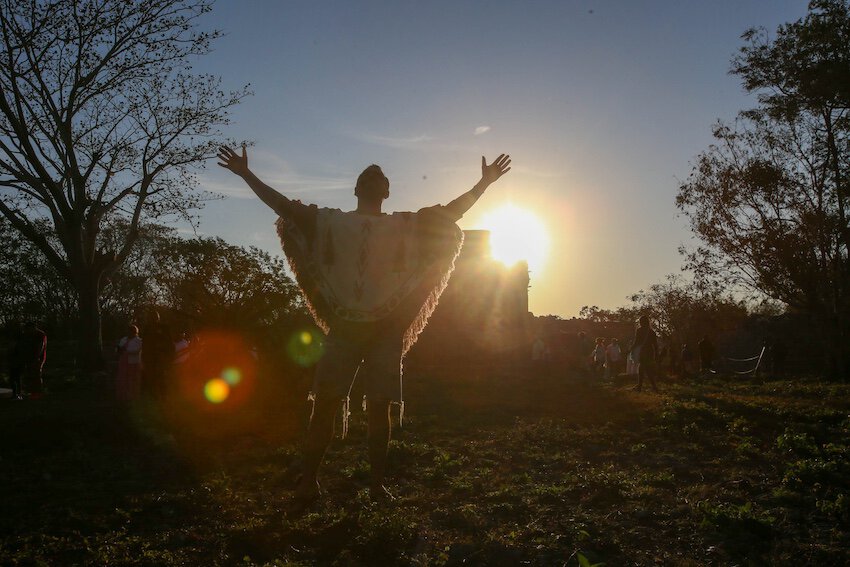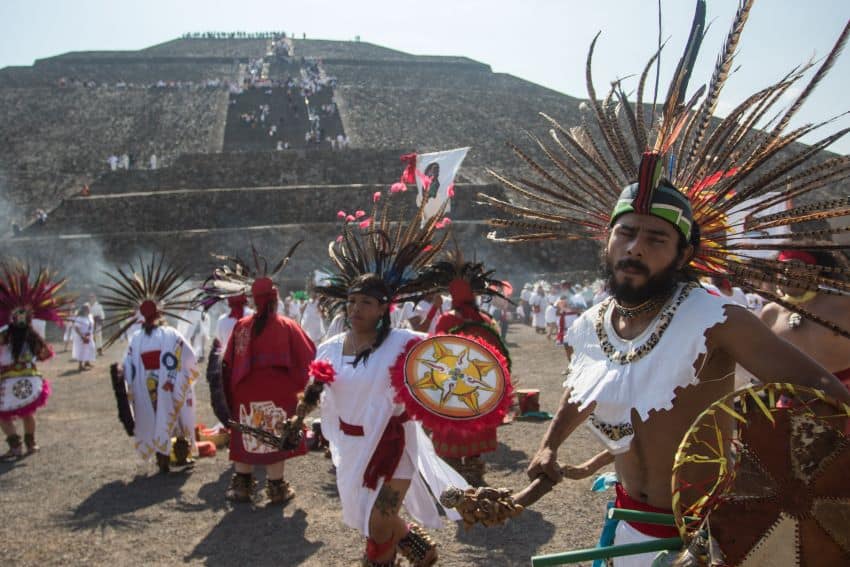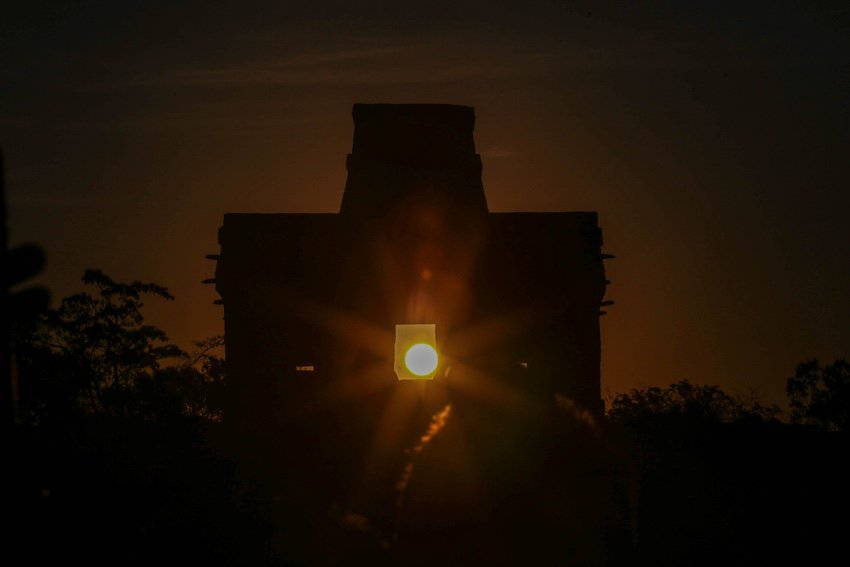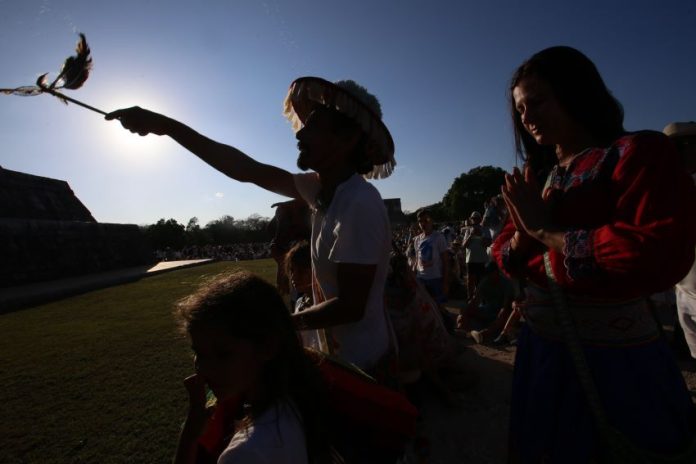In school, we learn that the spring and fall equinoxes mark equal night and daylight hours as well as the official change of seasons. In northern climes, it is a signal that the cold is ending. In Mexico, it is eagerly anticipated more as a sign of the impending rainy season, the defining phenomenon of agriculture here.
Modern technology marks this year’s spring equinox for March 19 at exactly 9:06 p.m. Mexico City time. However, in Mexico’s Mesoamerican archeological sites, the more important celestial event is the sun’s position on March 20 or 21.

Past and present come together as thousands of people flock to see the sun interact with monumental structures and continue honoring each site’s ancient spiritual significance.
Chichén Itzá
The most famous archaeological site for watching the equinox is Chichén Itzá in Yucatán state, in no small part because of the particular light and shadow show created by El Castillo, the pyramid that stands in the center of the site. The pyramid, built between the 8th and 12th centuries A.D., is itself a gigantic calendar.
Its four sides each have 91 steps, meaning that if we count its crowning platform as a step, the pyramid has 365 steps: one for each day of the year on the Maya Haab’ solar calendar. Each side has 18 terraces, reflecting the number of “uinal,” or 20-day months of the Haab’ — like the ancient Egyptians, the ancient Maya believed that the five leftover days at the end of the year were unlucky, calling them the Wayeb’, or “nameless days.” Each of El Castillo’s facades contains 52 carved panels — the same number of years in the Maya calendar round.

This year at exactly 3:24 p.m. on March 21, a series of triangular shadows will appear on the pyramid’s northwest stairs, and descend towards the serpent head at the base of the structure, creating the shape of a giant snake crawling down the pyramid. This event, called the Descent of Kulkulcan — the Plumed Serpent, a deity found across Mesoamerican cultures — was understood as the arrival of Kukulcan in his role as a fertility god, letting the ancient Itzás know that it was time to prepare the earth for the coming rains.
The public nature of this light show means that many people can gather in the plaza to witness it. In 2023, it drew over 20,000 visitors, a figure anticipated to rise significantly with the inauguration of the Maya Train.
Teotihuacán

In second place is Teotihuacán, both because of its international fame and proximity to Mexico City. As early as the 1960s, observers noted that the light of the spring sun hitting certain buildings created effects that could not be accidental. This was not only confirmed in detail at the site’s Palace of Quetzalpapálotl — or Palace of the Butterflies, for the many butterfly-shaped reliefs that adorn it — but at most Mesoamerican archeological sites since.
Built between A.D. 400 and 600, the palace is a complex structure in which light from the rising equinox sun hits the building’s crenels and casts a stepped shadow that strikes certain red and mica-incrusted figures on the interior west wall as it moves. However, due to the nature of the building, seeing this show live is nearly impossible. For most visitors on this day, the important thing is to be here at dawn to “absorb the energy” marked by the turning of the season, often performing ceremonies dressed in white. In the past, these ceremonies included climbing the pyramids, but that has been prohibited in the past decade or so. This does not discourage thousands of people from being at the site very early in the morning.
Going to either of these sites for the event is a once-in-a-lifetime experience, but be aware that they are very crowded. Going as part of a tour is recommended, not only for the information a guide can provide about what to see, but to make sure practical concerns, like transportation and lunch are taken care of.
Alternative sites
Growing knowledge about Mesoamerican sites means that there are more than two options to be awed by how much Mexico’s ancient cultures understood the workings of heaven and earth.
Recently, magazines like Mexico Desconocido have begun to promote other sites including Monte Albán in Oaxaca and Palenque in Chiapas. Both have noted solar observatories and have long been major cultural attractions.

In the Mexico City area alone, there are quite a few options other than Teotihuacan. In the city proper, the Templo Mayor in the Zócalo, Cuicuilco, Cerro de la Estrella and the Mixcoac archaeological site, all accessible via public transport, welcome visitors for the event Day trips from the capital include Cholula in Puebla, Tula in Hidalgo and Tenango del Valle in México state.
Other noted archeological sites with equinox activities include El Tajín in Veracruz, Guachimontones in Jalisco, Yagul in Oaxaca, Cañada de la Virgin in Guanajuato, La Quemada in Zacatecas and Tulum in Quintana Roo. These locations are likely to be less crowded but no less awe-inspiring, as each has its own story and local traditions that can come onto full display with dances, special guided tours and ceremonies.
It is important to note that not all of Mexico’s archeological sites open for the equinox. Some smaller ones specifically close due to lack of resources available to handle crowds. This year, the National Institute of Archeology and History (INAH) has expressed particular concern about several sites in Hidalgo state, including Tula, which suffered vandalism in past years. While these might seem to be punitive restrictions, the presence alone of a large number of people at the same time can cause damage to archaeological sites.
But growing interest does present an opportunity for smaller sites. Las Labradas in Sinaloa has begun scheduling special events to draw crowds to the site and educate the public of this northwestern state’s role in the Mesoamerican world with dances, rituals, food, presentations and much more.
Such offerings are growing and if properly managed, are not necessarily a bad thing. The equinox offers the opportunity to see Mesoamerican sites as something more than just static buildings. It can even remind us that the world is not really all that different than it was 1000 years ago.
Leigh Thelmadatter arrived in Mexico over 20 years ago and fell in love with the land and the culture in particular its handcrafts and art. She is the author of Mexican Cartonería: Paper, Paste and Fiesta (Schiffer 2019). Her culture column appears regularly on Mexico News Daily.
